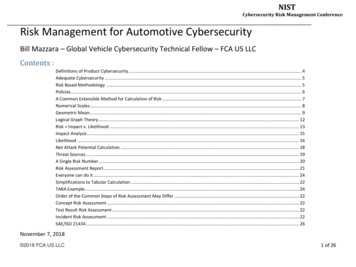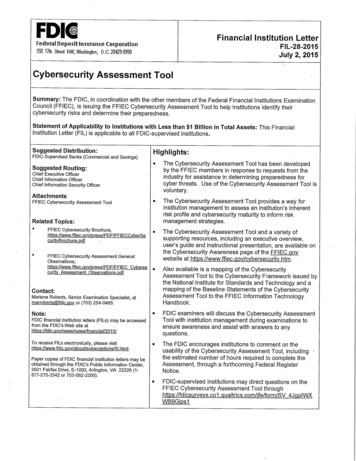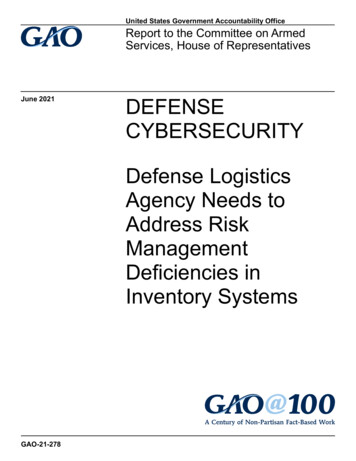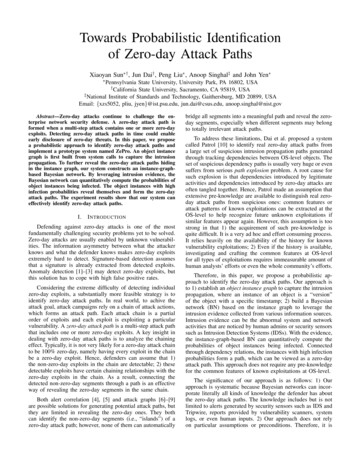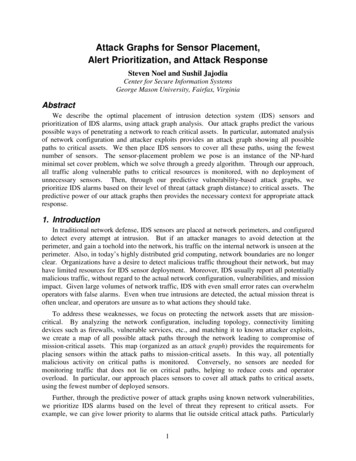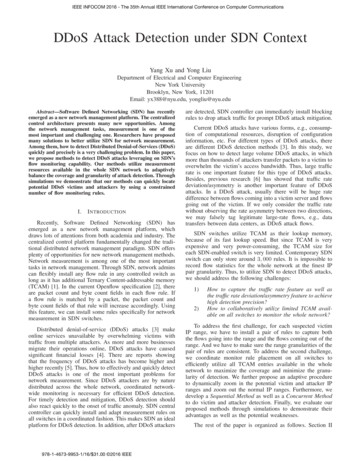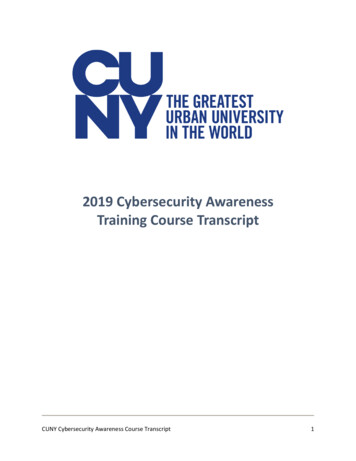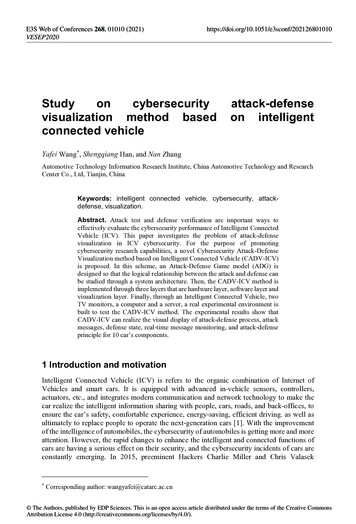
Transcription
E3S Web of Conferences 268, 01010 126801010Studyoncybersecurityvisualization method basedconnected vehicleattack-defenseon intelligentYafei Wang *, Shengqiang Han, and Nan ZhangAutomotive Technology Information Research Institute, China Automotive Technology and ResearchCenter Co., Ltd, Tianjin, ChinaKeywords: intelligent connected vehicle, cybersecurity, attackdefense, visualization.Abstract. Attack test and defense verification are important ways toeffectively evaluate the cybersecurity performance of Intelligent ConnectedVehicle (ICV). This paper investigates the problem of attack-defensevisualization in ICV cybersecurity. For the purpose of promotingcybersecurity research capabilities, a novel Cybersecurity Attack-DefenseVisualization method based on Intelligent Connected Vehicle (CADV-ICV)is proposed. In this scheme, an Attack-Defense Game model (ADG) isdesigned so that the logical relationship between the attack and defense canbe studied through a system architecture. Then, the CADV-ICV method isimplemented through three layers that are hardware layer, software layer andvisualization layer. Finally, through an Intelligent Connected Vehicle, twoTV monitors, a computer and a server, a real experimental environment isbuilt to test the CADV-ICV method. The experimental results show thatCADV-ICV can realize the visual display of attack-defense process, attackmessages, defense state, real-time message monitoring, and attack-defenseprinciple for 10 car’s components.1 Introduction and motivationIntelligent Connected Vehicle (ICV) is refers to the organic combination of Internet ofVehicles and smart cars. It is equipped with advanced in-vehicle sensors, controllers,actuators, etc., and integrates modern communication and network technology to make thecar realize the intelligent information sharing with people, cars, roads, and back-offices, toensure the car’s safety, comfortable experience, energy-saving, efficient driving. as well asultimately to replace people to operate the next-generation cars [1]. With the improvementof the intelligence of automobiles, the cybersecurity of automobiles is getting more and moreattention. However, the rapid changes to enhance the intelligent and connected functions ofcars are having a serious effect on their security, and the cybersecurity incidents of cars areconstantly emerging. In 2015, preeminent Hackers Charlie Miller and Chris Valasek*Corresponding author: wangyafei@catarc.ac.cn The Authors, published by EDP Sciences. This is an open access article distributed under the terms of the Creative CommonsAttribution License 4.0 (http://creativecommons.org/licenses/by/4.0/).
E3S Web of Conferences 268, 01010 126801010dominated headlines with their landmark hack of a Jeep Cherokee [2]. In 2016, team ofhackers take remote control of Tesla Model S from 12 miles away [9]. In 2017, Keen Labdiscovered new security vulnerabilities on Tesla motors and realized full attack chain toimplement arbitrary CAN Bus and ECUs remote controls on Tesla motors with latestfirmware [3]. In 2018, researchers hacked BMW cars and discovered 14 vulnerabilities [4].As the cybersecurity incidents of automobile are mostly signal attacks which are mostlyinvisible for human’s eye and even inaudible [5-7], people are so unfamiliar with automotivecybersecurity attacks that the effective protection measures cannot be taken to solve that.With the adoption of the Cybersecurity Law of the People’s Republic of China [8], peoplebegan to pay attention to the knowledge of cyber-attack and cyber-defense that are importanttechnologies to effectively evaluate the cybersecurity performance of Intelligent ConnectedVehicle (ICV). The research work and experiments on cybersecurity attack testing anddefense verification are gradually increasing. Whereas there is relatively little research on thevisualization method of cybersecurity attack and defense. Specifically, visualization is atheory, method and technique that uses computer graphics and image processing techniquesto convert data into graphics or images for display on the screen and then interactiveprocessing [9]. If visualization technology can be applied to the research and development ofautomotive cybersecurity attack-defense, it will not only enhance people's betterunderstanding of problems, facilitate dialogue, exploration and communication, but alsosimplify the complexity of research questions and enhance the review.In order to realize the visualization of automotive cybersecurity attack and defensetechnology research, this paper is motivated. The main contributions of this paper include thefollowing: (i) The Attack-Defense Game model (ADG). (ii) Cybersecurity Attack-DefenseVisualization Method Based on Intelligent Connected Vehicle (CADV-ICV). The remainderof this paper is organized as follows. Section 2 presents the design of Attack-Defense Gamemodel. Section 3 provides the implementation procedure of cybersecurity attack-defensevisualization method. Section 4 depicts the experimental result that includes the experimentalenvironment construction and the verification results. A conclusion is given in Section 5.2. Attack-defense game modelTaking ICV as the research object, the Attack-Defense Game model (ADG) betweenIntelligent Connected Vehicle (ICV) and hacker is designed in this section. Specifically, theADG model takes hacker’s malicious attack command as input, and the effect of ICV asoutput, such as attack-defense states, can message and real-time message monitoring. Itincludes attack flow and defense flow. The attack flow mainly consists of attack instructionssent by hackers, such as attack messages of door, window and throttle, and the defense flowis mainly composed of the security defense effect of the vehicle’s network protectionmechanism, such as car security access authentication, signature verification mechanism. Theworking principle of ADG model is shown as follow. Firstly, defense flow intercepts theinstructions in each attack flow and matches the corresponding defense measures. Then, ifthe interception is successful, the model outputs the information of defense success and attackfailure. Otherwise, the attack success and defense failure will be output. Subsequently, thevisualization module will show the state of the corresponding information during a vehicle’sattack-defense. Finally, the attack visualization and protection visualization modules worktogether to demonstrate a visual representation of their logical relationship.2
E3S Web of Conferences 268, 01010 ck MessageAttacking MessageVehicle ModelMessage MonitorOUTPUTDefense flowAttack Pro cessWiperAttack Detection VisualizaitonSteerAttack-Defense Game ModelDefense failed/succeedAttack s ucceed/failedAttack flowAttack-Defense Game ModelINPUTHackers Malicious AttackDefense Verification VisualizationWindo wRemote Terminal CommunicaitonDoorDefensePro cessWindo wAttack ResultIntelligent Connected Vehicle SystemAttack StatusDoorRemote Terminal CommunicaitonAttack 010DoorWindo s MessageDefensive StatusFailedDefenseSucceedDefensive TechnologyTSPAPPIVIECUT-Bo xRadioFig. 1. The Attack-Defense Game model.In the CADV-ICV method, the attack and defense visualization is realized in the form ofa display platform interface, and the visualization method mainly utilize HTML5, jQuery andCSS3 technologies for development, and it implemented real-time communication throughthe socket based on the terminal communication technology. According to the change of realtime data, dynamic effects display is performed by using canvas technology and CSSanimation. The visual page layout is mainly implemented by a combination of percentageand flex layout. The attack-defense visual interface is mainly composed of two pages: attackdetection visualization and defense monitoring visualization. The ADG model is used tovisually present the ICV’s three network states, which are no attack, defense failure (attacksuccess) and defense success (attack failure) .The Attack Detection Visualization (ADV) design is based on the Button Group, PromptBox, Status Group, List Group, and Popup. It can implement attack intent visualization,attack status visualization, attack result visualization, and attack message visualization,which are presented as follow.a). Attack Intent Visualization (AIV), which is built to visualize the malicious hackingprocess of ten components, such as door, window, steering wheel, wiper, trunk, lights, throttle,speed, brake and seat. In particular, when each attack intention occurs, the window textprompt and the voice broadcast corresponding attack intention are displayed, and the buttongroup corresponding item is pressed after 3 seconds. For example, when the door is attacked,the window text prompt and voice broadcast that the door is attacked, and the door button ispressed after 3 seconds.b). Attack Status Visualization (ASV), which corresponds to the attack intentvisualization, which visualizes the current state of the door, window, steering wheel, wiper,trunk, lights, throttle, speed, brake and seat. By the way, the normal state is green and theattackend state is red in our proposed method. For example, when the car door is attacked,the door in the attack intent visualization is in the pressed state, and the door item in the attackstate visualization is rendered as the attacked red.c). Attack Result Visualization (ARV), which presents the output of the ADG model inthe form of local state popup and background motion. It is made up of two states of defensefailure (attack success) and defense success (attack failure).d). Attack Message Visualization (AMV), which is based on the List Groupdevelopment, the message signal of the car being attacked is visualized in a scrolling manner.The Defense Monitoring Visualization (DMV) development is based on the Status Group,Message List and Status Panel, which enables automotive model visualization, messagemonitoring visualization, defense status visualization and defense technology visualization,which are depicted as follows.a). Automotive Model Visualization (AMV), which fully presents the security status ofimportant parts of the car in the form of a schematic diagram of the vehicle model. When oneof the car’s components (windows, steering wheel, wipers, trunk, lights, throttle, speed, brakeand seats) is attacked, the corresponding part will become red.3
E3S Web of Conferences 268, 01010 126801010b). Message Monitoring Visualization (MMV), which is based on the Message Listdevelopment. In MMV, the current message status of the car’s network is displayed in realtime, and the message display updates the form data according to the socket push based onthe remote terminal communication technology.c). Defense Status Visualization (DSV), which is based on the State Panel development.It can dynamically visualizes the working status of the vehicle protection system, includingthree states, which are system protecting, defense succeed and defense failed.d). Defense Technology Visualization (DTV), which is based on the State Groupdevelopment, It statically visualizes the security protection measures that the ICV system hastaken.3 Method and implementationRelying on the ADG model, a novel Cybersecurity Attack-Defense Visualization methodbased on Intelligent Connected Vehicle (CADV-ICV) is proposed in this section. It realizesthe visual presentation of the state of the car units around the ten important functional units(windows, steering wheel, wipers, trunk, lights, throttle, speed, brake and seats), as well asthe visual presentation of the relationship between external attack and internal defense forICV’s system. The CADV-ICV method is implemented through three layers (Fig.2) that arehardware layer, software layer and visualization layer, which are presented as follows.a). Hardware implementationThe hardware layer implementation mainly completes the deployment of the hackerdevices, the Intelligent Connected Vehicle, the remote communication terminal, the cloudserver, and the front-end display device. Specifically, the hacker device deployment includesa technician and an attack device computer. Intelligent Connected Vehicle is the main attackobject of hacker. The remote terminal communication is deployed on the IntelligentConnected Vehicle to realize the monitoring of the vehicle’s state. The cellular remotecommunication technology uploads the vehicle’s status data to the cloud server. The cloudserver is responsible for the collection and processing of the vehicle status data. Thevisualization screen is used as the display of invisible information, such as attack signal,vehicle’s message, vehicle components states.b). Software layer implementationThe software layer implements five major functions: attack message sending, CANmessage collection, collected message transmission, message data analysis, and statusinformation display. The attack message is sent by the hacker device. The CAN messagecollection is based on the Intelligent Connected Vehicle, which realizes the collection of theCAN message data of the car’s system. The collected message transmission uploads thecollected message data to the cloud server by means of the remote communication terminal.The message data analysis is performed on the cloud server and the information content ofthe packet data is parsed. The status information display is output to the front-end display tocomplete.c). Visualization layer implementationThe visualization layer is implemented on the basis of the support of the hardware layerand the software layer. Through the HTML5 Web socket, TCP, JQuery, CSS3 and canvastechnologies, it realize the visualization of the attack state and the visualization of the defensestate, and the ICV’s attack and defense game of the intelligent network is visually displayed.4
E3S Web of Conferences 268, 01010 126801010Fig. 2. The attack-defense game model.4 Experiment result4.1 Experimental enviromentIn our experiment, an Intelligent Connected Vehicle, two TV monitors, a computer and aserver are selected to build an experimental environment to test the proposed method ofCADV-ICV. Based on the ADG model, we designed the system interface as shown in Fig.3.Fig.3 (a) is an attack visualization experiment interface to visualize the information relatedto car’s attacks. Fig.3 (b) is a protective visualization experiment interface to visualize thecar’s protection information.(a). Attack visualization(b). Defense VisualizationFig. 3. Experiment environment interface.5
E3S Web of Conferences 268, 01010 1268010104.2 ResultsBased on the visual experimental environment that has been built, attack-defensevisualization experiment was carried out on the top ten functional units (windows, steeringwheel, wipers, trunk, lights, throttle, speed, brake and seats) of the car to test the validationof the CADV-ICV method. In the application, we exploited the car CAN bus protocolvulnerability to simulate the hacking behavior to attack the car. As well as the situation whenthe car defense system intercepted the car in the face of external attacks. The results showthat CADV-ICV can realize the visualization of cybersecurity attack-defense for ICV, andthe visualization contents covered the attack states, attack messages, real-time messagemonitoring, and defensive measures, which are shown in Fig.4. Besides, the experiment gavethe result of the attack-defense principle’s verification for 10 units of car in Tab.1. It isnoticeable that attack and defense are two opposite faces.(a) Attack state(b) Attack messages(c) Real-time message monitoring(d) Defensive measuresFig. 4. CADV-ICV method application.Table 1. Verification results of CADV-ICV method.UnitsWindowsSteering fenseSucceedSucceedSucceedSucceedVerified resultPassedPassedPassedPassed
E3S Web of Conferences 268, 01010 ailedFailedFailedFailedFailedFailedPrompt and ssedPassedPassedPassed(a) Visualization of statusFig. 5. Attack visualization.Take the experiment when the car steering wheel receives an attack for instance, when itis attacked, the experimental result is shown in Fig 5. Fig 5 (a) is a pop-up prompt and voicewarning broadcast of the steering wheel being attacked. Fig 5 (b) shows the visualization andstatus of the attacked message on the steering wheel. and the red part indicates where the carwas attacked. Corresponding to the situation in Fig 5, Fig 6 gives the visual representation ofthe current defense state and attacked parts of the automotive system. Besides, the car'ssuccessful defense status is shown in Fig 7, which is the same as the running states when thecar does not receive any external attacks. Once it receives an external attack, the interfacewill change to Fig 6. Furthermore, Fig 8 shows the visualization results when the twofunctional elements of the car are attacked at the same time, and the red parts indicate wherethe car were attacked.Fig. 6. Hacked situation.7
E3S Web of Conferences 268, 01010 126801010Fig.7. Defense succeed result.Fig.8. Multiple units were hacked.5 ConclusionThis paper investigated a novel approach of CADV-ICV to address the problem of invisibleinformation flow in ICV’s cybersecurity. The method not only can help to improve thesecurity performance of automotive information, but also can popularize automotivecybersecurity knowledge to the audience. Specifically, the ADG model has been designedbased on Intelligent Connected Vehicle, which presents the logical relationship between theICV’s attack and defense as well as information flow. Then, the CADV-ICV method hasbeen implemented through three layers that are hardware layer, software layer andvisualization layer. Finally, an ICV real experimental environment has been built to conductthe test. The results demonstrate the effectiveness of the proposed method.This work described in this article has been supported by Automotive Data Center of China AutomotiveTechnology and Research Center Co., Ltd. It provides the laboratory, the experiment car, testinghardware device and support required to carry out this method successfully.Reference1.2.Y. Li, Y. Cao, H. Qiu, L. Gao, Z. Du and S. Chen, Big wave of the intelligent connectedvehicles, in China Communications, 13 (2), 27-41, welivesecurity.com/2016/09/21/tesla-model-s-hack/. Accessed 17 Jan20198
E3S Web of Conferences 268, 01010 51/e3sconf/202126801010New Car Hacking Research: 2017, Remote Attack Tesla Motors rs-Again/. Accessed 16 Jan -bmw-cars/. Accessed 17 Jan 2019Parkinson, S.: Cyber threats facing autonomous and connected vehicles: futurechallenges. IEEE Trans. Intell. Transp. Syst. 18(11), 2898–2915 (2017)Sadek, A.: Special issue on cyber transportation systems and connected vehicle research.J. Intell. Transp. Syst. 20(1), 1–3 (2016)Luo, Q.: Wireless telematics systems in emerging intelligent and connected vehicles:threats and solutions. IEEE Wirel. Commun. 25(6), 113–119 (2018)(Authorized to publish) People's Republic of China Cyber Security Lawhttp://www.xinhuanet.com/politics/2016-11/07/c 1119867015.htmWei Zong, Yang-Wai Chow, Willy Susilo. Interactive three-dimensional visualizationof network intrusion detection data for machine learning[J]. Future GenerationComputer Systems, 2020,102.9
began to pay attention to the knowledge of cyber -attack and cyber-defense that are important technologies to effectively evaluate the cybersecurity performance of Intelligent Connected Vehicle (ICV).The research work and experiments on cybersecurity attack testing and defense verification are gradually increasing.
